Flow Control Market Size
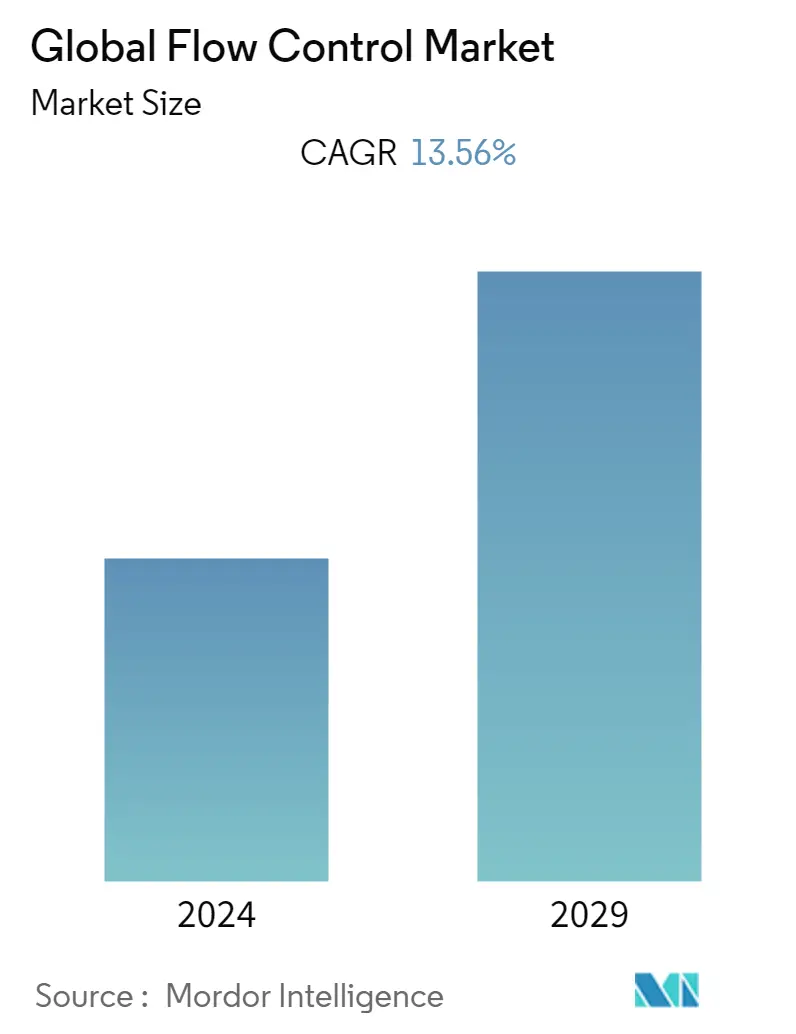
| Study Period | 2019 - 2029 |
| Base Year For Estimation | 2023 |
| CAGR | 13.56 % |
| Fastest Growing Market | Asia-Pacific |
| Largest Market | Asia-Pacific |
| Market Concentration | Medium |
Major Players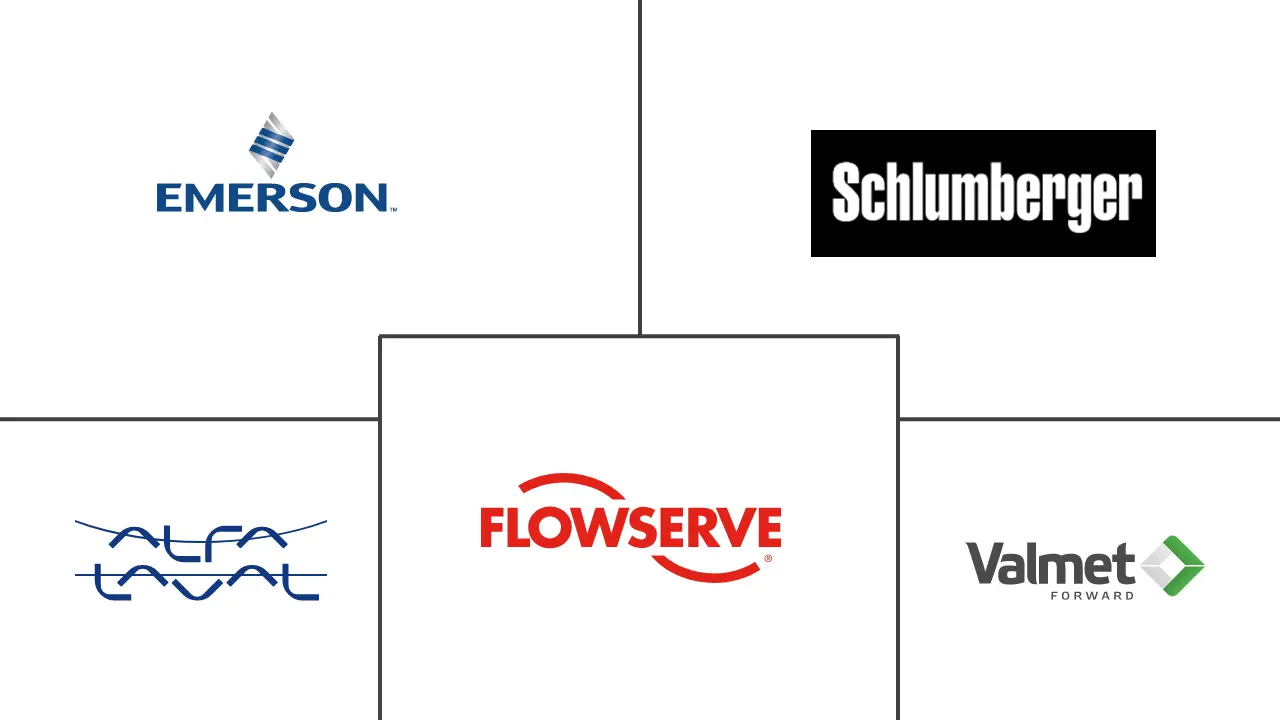
*Disclaimer: Major Players sorted in no particular order |
Flow Control Market Analysis
The global flow control market is expected to grow at a CAGR of 13.56% over the forecast period (2022-2027). Flow control solutions govern liquid and gas flow and pressure. The market is growing due to rising product demand from end-use sectors such as oil & gas, electricity, and construction. Flow control solutions are applicable for vertical, deviated, and horizontal completions and are suitable for inflow optimization and production maximization.
- The market for flow control solutions is also rising due to the growing trend of industrial automation across various industries. An increasing number of power-producing units, and rising power consumption in developing nations, are boosting market expansion.
- IoT solutions lower the cost of equipment operations while also lowering the danger of fatalities. Maintenance and repair specialists, for instance, seldom forecast equipment failure before the introduction of small smart sensors and only realized there was an issue when seen, which resulted in a substantial amount of time wasted on procurement (waiting for spare parts to arrive), disruption of several business processes, and a major drop in production efficiency. Oil and gas industries may now foresee and avoid problems utilizing IoT capabilities.
- The Covid-19 pandemic significantly impacted industrial sectors such as oil and gas, chemicals, power, metals, and mining. As a result, demand for the goods produced by these industries declined. The market, however, significantly increased in various industrial sectors serving the pharmaceutical, energy, and utility applications. Additionally, the pandemic dramatically accelerated industrial automation, leading to a surge in product innovations.
- For instance, in February 2022, Circor International, Inc. launched the CIR 3100 control valve, a new valve body with a variety of internal options for a wide range of general, critical, and severe applications, including oil and gas, power generation, processing industries, maritime, and renewables.
- Valve makers must follow several standards and rules. When it comes to valves, different locations have distinct certifications and policies. As valves are used in many industries, such as oil & gas, food & beverage, pharmaceuticals, energy & power, water & wastewater treatment, building & construction, chemicals, and pulp & paper, demand is diverse. However, such variation impedes the valves market's growth because manufacturers must adopt the same product to regional policies, making it difficult for valve makers to obtain an ideal installation cost.
Flow Control Market Trends
This section covers the major market trends shaping the Flow Control Market according to our research experts:
Oil and Gas Industry is Analyzed to Hold Major Share
- In the oil and gas industry, the smallest leakages could cause a disaster; flow control plays a critical role in safeguarding plants from catastrophe and maximizing the production of the different products. Valves play a crucial role in the flow control of the processes. The oil and gas industry is expected to dominate the end-user market. Treatment, production, distribution, and processing of hydrocarbon fluids and gases are part of the oil and gas sector-the market benefits from the rising demand for petrol and diesel in developed economies. The market is also expanding due to the rising population and increased use of passenger automobiles and cooking gas. Flow controls are utilized in various oil and gas applications, including upstream production, pipeline detection, and gas processing.
- Schlumberger announced in March 2022 that Saudi Aramco had awarded it a substantial contract for integrated drilling and well-building services in a gas drilling project. Drilling rigs, technologies, and services, such as drill bits, measurement while drilling (MWD) and logging while drilling (LWD), drilling fluids, cementing, and completing wells, are all included in the integrated project scope. Schlumberger will use digital solutions to improve integrated drilling performance, such as the DrillOps on-target well delivery solution, which employs data analysis, learning systems, and automation to execute a digital well plan, resulting in increased drilling efficiency, consistency, and performance.
- In January 2022, Indian Oil Corp. Ltd. (IOCL) announced plans to invest INR 7,000 crore in its city gas distribution (CGD) business. Indian Oil Corp (IOC) announced an INR 1 lakh crore investment in August 2021 to nearly triple its refining capacity over the next 4-5 years.
- In April 2022, the Japan Ministry of Oil and Gas stated that country plans to step up its investment role in upstream projects for liquefied natural gas (LNG) to spur new development and boost fuel offtake by its companies.
- Further, A different set of flow control requirements are needed for each kind of power generation application. That so, a power plant's particular pipeline system may contain a wide variety of valves. Industrial valves for power plants also need to play diverse roles depending on the operations occurring in a specific area of the pipe system. In nuclear power plants, control valves are frequently employed to control fluid flux, and the principal circuit of one nuclear power plant contains more than 1500 control valves.
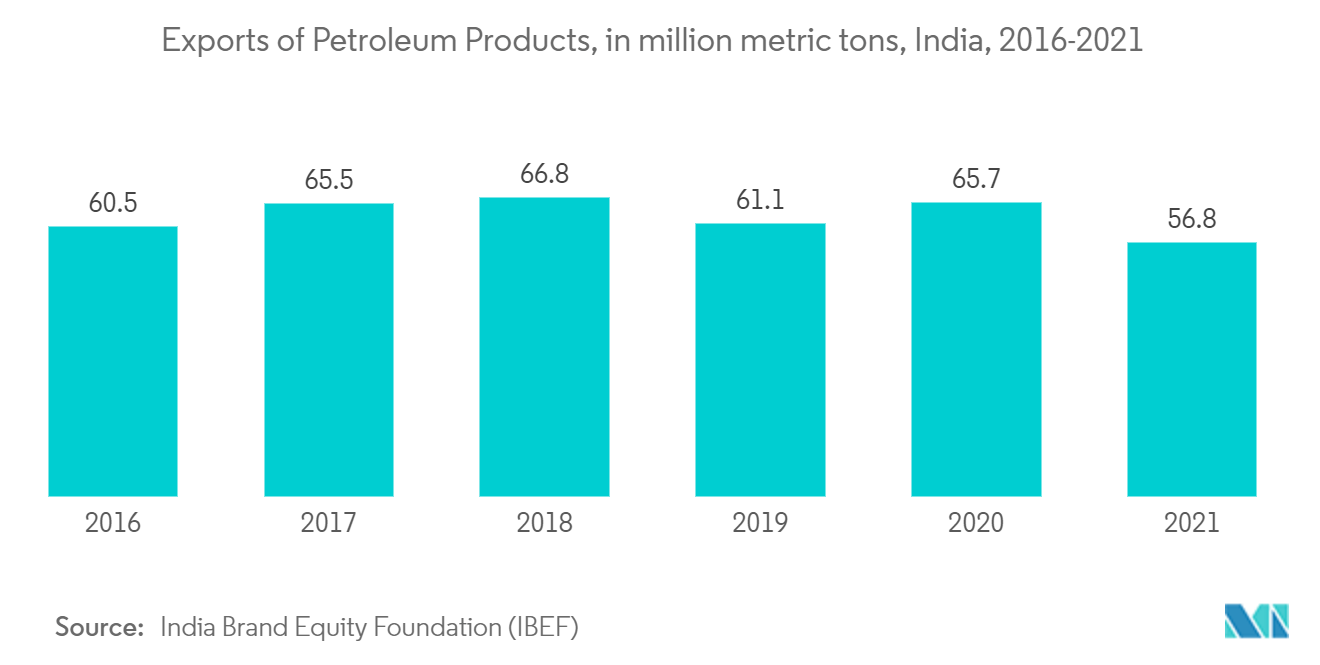
Asia Pacific is Expected to Register the Fastest Growth Rate
- In the market for flow control, Asia Pacific will emerge as a major region. Rapid industrialization is increasing market growth in rising economies such as China, India, Japan, and South Korea. The industry is being propelled forward by the region's growing manufacturing sector and the increasing use of oil and gas. China plans to extend its giant gas pipeline grids to 163,000 kilometers by 2025, necessitating a USD1.9 trillion investment.
- IBEF states that India is anticipated to contribute to global non-OECD petroleum consumption growth significantly. Crude oil imports increased dramatically from USD 70.72 billion in FY17 to USD 94.3 billion in FY22 (April to January). India's oil refining capacity was 248.9 million metric tonnes per annum (MMTPA) on September 1, 2021, making it Asia's second-largest refiner. Private businesses controlled about 35% of the total refining capacity. With a capacity of 69.7 MMTPA, IOC is the largest domestic refiner.
- In January 2022, Adani Total Gas Ltd (ATGL), a joint venture between the Adani Group and TotalEnergies, acquired permits to expand its City Gas Distribution (CGD) network to 14 new geographical areas with an investment of INR 20,000 crore.
- In September 2021, SK E&S, the natural gas arm of South Korean refiner and energy conglomerate SK, set a target of producing 280,000 t/yr of mostly blue hydrogen, supplying 10 million t/yr of eco-friendly LNG, and operating 7GW of renewable energy by 2025, as part of a plan to increase the company's value fivefold to KRW 35 trillion.
- Moreover, the significant demand from the power sector is also a driving factor for the market. For instance, in 2021, China generated 8.11 trillion kilowatt-hours (KWh), an increase of 8.1 percent from the previous year. (National Bureau of Statistics (NBS))
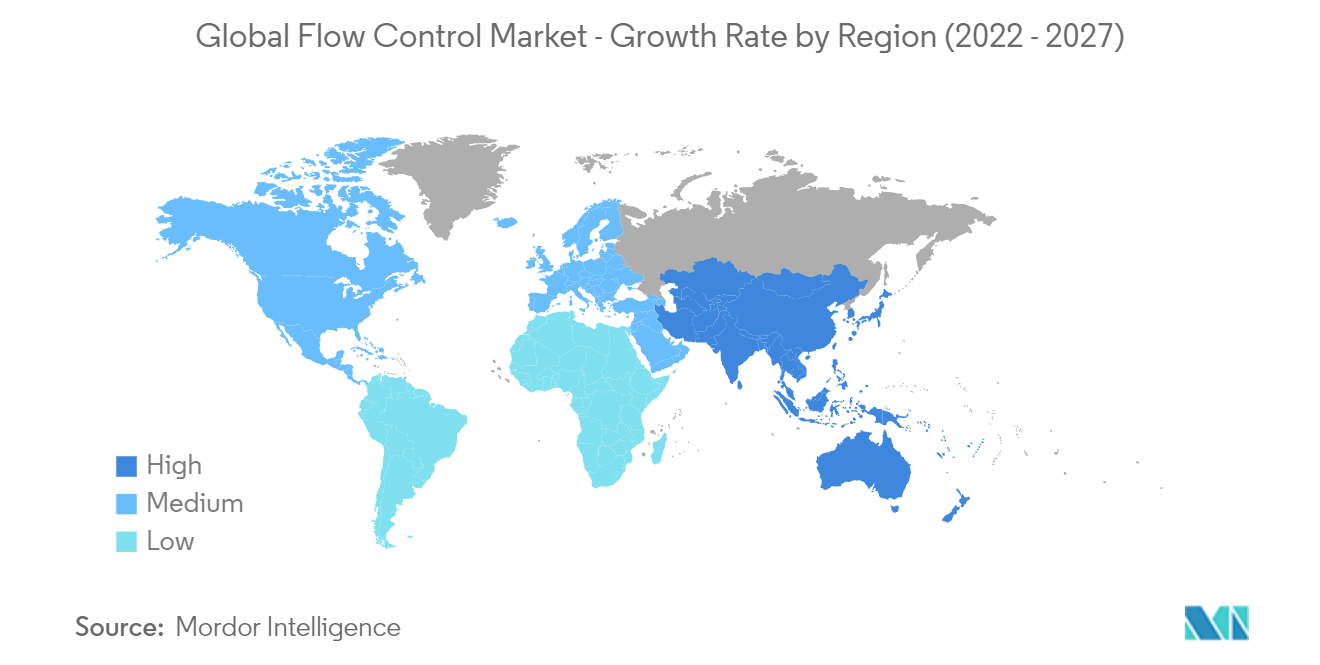
Flow Control Industry Overview
The Global Flow control market is moderately competitive, with a considerable number of regional and global players, and moderately fragmented. The market vendors are focusing on expanding their customer base across foreign countries. The companies are leveraging strategic collaborative initiatives to increase market share and profitability.
- April 2022 - Following the completion of the merger between Neles and Valmet, the Flow Control Business Line under Valmet will carry on Neles' operations. Neles has been dissolved as a result of the registration of the Merger's completion.
- March 2022-TotalEnergies awarded Schlumberger an extensive contract for drilling, completions, and production services for its Tilenga onshore oil development in Uganda. The agreement covers directional drilling, upper and lower completions, artificial lift systems, and wellheads for the Tilenga development, which consists of six fields with a total of 426 wells spread across 31 well pads.
Flow Control Market Leaders
-
Emerson Electric Co.
-
Schlumberger Limited
-
Valmet Oyj
-
Alfa Laval Corporate AB
-
Flowserve Corporation
*Disclaimer: Major Players sorted in no particular order
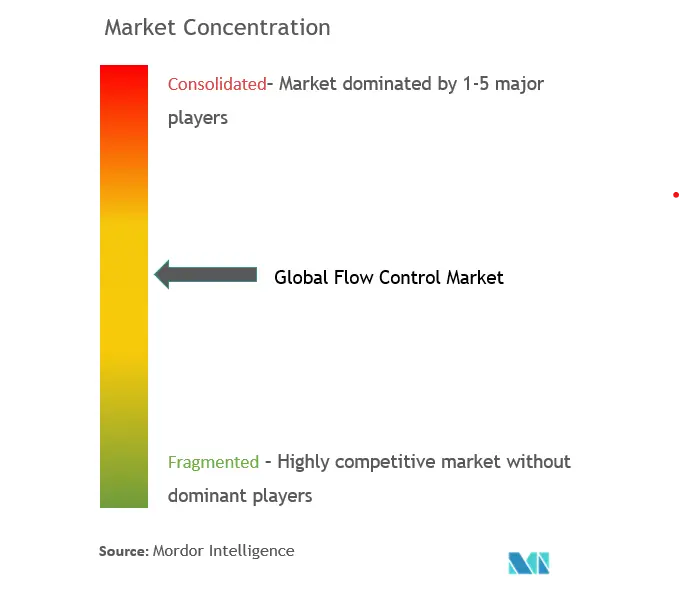
Flow Control Market News
- July 2022- Valmet announced the addition of Neles Q-Disc, a new high-performance feature that aids flow balancing in control valve applications, to its flexible butterfly valve product line. The launch completes the line-up of the Jamesbury Wafer-Sphere butterfly valve platform and modular Neles Neldisc butterfly valve that was released to the market in June 2021.
- November 2021-Weatherford International plc announced that it was awarded two five-year contracts with Abu Dhabi National Oil Company (ADNOC) with a value of more than USD 1 billion for downhole equipment and liner hanger systems.
Flow Control Market Report - Table of Contents
1. INTRODUCTION
- 1.1 Study Assumptions and Market Definitions
- 1.2 Scope of the Study
2. RESEARCH METHODOLOGY
3. EXECUTIVE SUMMARY
4. MARKET INSIGHTS
- 4.1 Market Overview
-
4.2 Industry Attractiveness - Porters Five Force Analysis
- 4.2.1 Bargaining Power of Suppliers
- 4.2.2 Bargaining Power of Buyers/Consumers
- 4.2.3 Threat of New Entrants
- 4.2.4 Threat of Substitute Products
- 4.2.5 Intensity of Competitive Rivalry
- 4.3 Value Chain / Supply Chain Analysis
- 4.4 Assessment of the Impact of COVID -19 on the Market
-
4.5 Technology Snapshot
- 4.5.1 Inflow control devices(ICDs)
- 4.5.2 Outflow control devices(OCDs)
- 4.5.3 Autonomous inflow control devices(AICDs)
5. MARKET DYNAMICS
-
5.1 Market Drivers
- 5.1.1 Growing need for connected networks to maintain and monitor industrial equipment
- 5.1.2 Utilization of IIoT and Industry 4.0 in industrial plants
-
5.2 Market Restraints
- 5.2.1 Lack of standardized certifications and government policies
6. MARKET SEGMENTATION
-
6.1 By Equipment Type
- 6.1.1 Pumps
- 6.1.2 Valves
- 6.1.3 Regulators
- 6.1.4 Meters
- 6.1.5 Others
-
6.2 By Application
- 6.2.1 Oil & gas
- 6.2.2 Power
- 6.2.3 Marine
- 6.2.4 Mining
- 6.2.5 Electronics
- 6.2.6 Water and Wastewater
- 6.2.7 Other Applications
-
6.3 Geography
- 6.3.1 North America
- 6.3.2 Europe
- 6.3.3 Asia Pacific
- 6.3.4 Latin America
- 6.3.5 Middle East and Africa
7. COMPETITIVE LANDSCAPE
-
7.1 Company Profiles
- 7.1.1 Emerson Electric Co.
- 7.1.2 Schlumberger Limited
- 7.1.3 Alfa Laval Corporate AB
- 7.1.4 Flowserve Corporation
- 7.1.5 Crane Co.
- 7.1.6 Rotork Plc
- 7.1.7 Valmet Oyj
- 7.1.8 KITZ Corporation
- 7.1.9 IMI Critical Engineering
- 7.1.10 Samson Controls Inc.
- *List Not Exhaustive
8. INVESTMENTS ANALYSIS
9. FUTURE TRENDS
** Subject To AvailablityFlow Control Industry Segmentation
Flow control is a part of the more comprehensive industrial sector, which consists of firms that provide products or services concerning the management and control of liquids and gases. Such products comprise pumps, valves, meters, and other related equipment. The Global Flow Control Market is Segmented by Equipment Type(Pumps, Valves, Meters, and others), By Application (Oil & Gas, Power, Marine, Mining, Electronics), and Geography.
| By Equipment Type | Pumps |
| Valves | |
| Regulators | |
| Meters | |
| Others | |
| By Application | Oil & gas |
| Power | |
| Marine | |
| Mining | |
| Electronics | |
| Water and Wastewater | |
| Other Applications | |
| Geography | North America |
| Europe | |
| Asia Pacific | |
| Latin America | |
| Middle East and Africa |
Flow Control Market Research FAQs
What is the current Global Flow Control Market size?
The Global Flow Control Market is projected to register a CAGR of 13.56% during the forecast period (2024-2029)
Who are the key players in Global Flow Control Market?
Emerson Electric Co., Schlumberger Limited, Valmet Oyj, Alfa Laval Corporate AB and Flowserve Corporation are the major companies operating in the Global Flow Control Market.
Which is the fastest growing region in Global Flow Control Market?
Asia-Pacific is estimated to grow at the highest CAGR over the forecast period (2024-2029).
Which region has the biggest share in Global Flow Control Market?
In 2024, the Asia-Pacific accounts for the largest market share in Global Flow Control Market.
What years does this Global Flow Control Market cover?
The report covers the Global Flow Control Market historical market size for years: 2019, 2020, 2021, 2022 and 2023. The report also forecasts the Global Flow Control Market size for years: 2024, 2025, 2026, 2027, 2028 and 2029.
Flow Control Industry Report
Statistics for the 2024 Flow Control market share, size and revenue growth rate, created by Mordor Intelligence™ Industry Reports. Flow Control analysis includes a market forecast outlook to 2029 and historical overview. Get a sample of this industry analysis as a free report PDF download.



